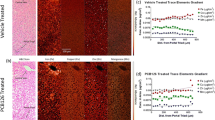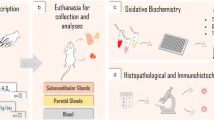Abstract
Liver regeneration after partial hepatectomy (pHx) is a well-defined process, which involves the concerted action of extra- and intracellular factors resulting in induction of cell replication and its inhibition at the time when the entire liver mass is restored. Concomitantly, the breakdown of previously maintained tolerance and the exposure of self-antigens lead to the activation of preimmune and immune repertoires, which participate in surveillance against aberrant cells and the re-establishment of previous morphostasis. Because, in these events, important biological function might have tissue minerals that are affecting the structural integrity and enzyme activities, transduction signals, transcription and replication factors during cell proliferation and apoptosis, as well as the development and maintenance of immune functions and cytokine production, in this study we analyzed tissue dynamics of zinc, ioron magnesium, and calcium in the liver, thymus, spleen, and submandibular gland in intact and pHx mice on the 1st, 2nd, 7th, and 15th d after one-third pHx, using microwave digestion and inductivity coupled plasma spectrometry. The data showed that pHx induces significant and interconnected changes in all of the estimated metals not only in the regenerating liver but also in the lymphatic tissues and submandibular gland, indicating their importance for the control of growth processes.
Similar content being viewed by others
References
N. Fausto, A. D. Laird, and E. M. Webber, Liver regeneration. 2. Role of growth factors and cytokines in hepatic regeneration, FASEB J. 9, 1527–1536 (1995).
G. K. Michalopoulos and M. C. DeFrances, Liver regeneration, Science 276, 60–66 (1997).
N. Fausto, Liver regeneration and repair: hepatocytes, progenitor cells, and stem cells, Hepatology 39, 477–487 (2004).
R. Traub, Liver regeneration: from myth to mechanism, Nature Rev. 5, 836–847 (2004).
E. M. Webber, J. Bruix, R. H. Pierce, et al., Tumor necrosis factor primes hepatocytes for DNA replication in the rat, Hepatology 28, 1226–1234 (1998).
A. M. Diehl and R. M. Rai, Liver regeneration 3: Regulation of signal transduction during liver regeneration, FASEB J. 10, 215–227 (1996).
B. A. Haber, K. L. Mohn, R. H. Diamond, et al., Induction patterns of 70 genes during nine days after hepatectomy define the temporal course of liver regeneration, J. Clin. Invest. 9, 1319–1326 (1993).
J. H. Albrecht and L. K. Hansen, Cyclin D1 promotes mitogen-independent cell cycle progression in hepatocytes, Cell Growth Differ. 10, 397–404 (1999).
D. B. Stolz, W. M. Mars, B. E. Petersen, et al., Growth factor signal transduction immediately after two-thirds partial hepatectomy in the rat, Cancer Res. 59, 4954–4960 (1999).
P. Skov Olsen, S. Boesby, P. Kirkegaard, et al., Influence of epidermal growth factor on liver regeneration after partial hepatectomy in rats, Hepatology 8, 992–996 (1988).
S. Noguchi, Y. Ohba, and T. Oka, Influence of epidermal growth factor on liver regeneration after partial hepatectomy in mice, J. Endocrinol. 128, 425–431 (1991).
M. Jo, D. B. Stolz, J. E. Esplen, et al., Cross-talk between epidermal growth factor receptor and c-Met signal pathways in transformed cells, J. Biol. Chem. 275, 8806–8811 (2000).
J. L. Cruise, S. J. Knechtle, R. R. Bollinger, et al., Alpha 1-adrenergic effects and liver regeneration, Hepatology 7, 1189–1194 (1987).
P. Matzinger, The danger model: a renewed sense of self, Science 296, 301–305 (2002).
T. Abo, T. Kawamura, and H. Watanabe, Physiological responses of extrathymic T cells in the liver, Immunol. Rev. 174, 135–149 (2000).
T. Kato, Y. Sato, S. Takalashi, et al., Involvement of natural killer T cells and granulocytes in the inflammation induced by partial hepatectomy, J. Hepatol. 40, 285–290 (2004).
T. Naito, T. Kawamura, M. Bannai, et al., Simultaneous activation of natural killer T cells and autoantibody production in mice injected with denatured syngeneic liver tissue, Clin. Exp. Immunol. 129, 397–404 (2002).
A. Bendelac, Mouse NK1+T cells, Curr. Opln. Immunol. 7, 367–374 (1995).
D. I. Godfrey, H. R. MacDonald, M. Kronenberg, et al., NKT cells: what's in a name? Nat. Rev. Immunol. 4, 231–237 (2004).
B. Radosevic-Stasic, Z. Trobonjaca, J. Ravlic-Gulan, et al., On the role of natural killer cells in liver regeneration, Period. Biol. 100, 429–434 (1998).
I. Mrakovcic-Sutic, M. Simin, D. Radic, et al., Syngeneic pregnancy induces overex-pression of natural killer T cells in matermal liver, Scand. J. Immunol. 58, 358–366 (2003).
I. Mrakovcic-Sutic, B. Radosevic-Stasic, M. Simin, et al., Augmentation of NKT and NK cell-mediated cytotoxicity by peptidoglycan monomer linked with zinc, Mediators Inflamm. 11, 129–135 (2002).
J. F. Bach Autoimmume diseases as the loss of active “self-control”, Ann. NY Acad. Sci. 998, 161–177 (2003).
H. Tapiero and K. D. Tew, Trace elements in human physiology and pathology: zinc and metallothioneins, Biomed. Pharmacother. 57, 399–411 (2003).
A. S. Prasad, Zinc deficiency: its characterization and treatment, Metal Ions Biol. Syst. 41, 103–137 (2004).
P. J. Fraker and L. E. King, Reprogramming of the immune system during zinc deficiency, Annu. Rev. Nutr. 24, 277–298 (2004).
L. Rink and P. Gabriel, Zinc and the immune system, Proc. Nutr. Soc. 59, 541–552 (2000).
E. Mocchegiani, R. Giacconi, E. Muti, et al., Zinc, immune plasticity, aging, and successful aging: role of metallothionein, Ann. NY Acad. Sci. 1019, 127–134 (2004).
M. D. Lastra, R. Pastelin, A. Camacho, et al., Zinc intervention on macrophages and lymphocytes response, J. Trace Elements Med. Biol. 15, 5–10 (2001).
T. Dudev and C. Lim, Principles governing Mg, Ca, and Zn binding and selectivity in proteins, Chem. Rev. 103, 773–788 (2003).
M. P. Vaquero, Magnesium and trace elements in the elderly: intake, status and recommendations, J. Nutr. Health Aging 6, 147–153 (2002).
P. Evans and B. Halliwell, Micronutrients: oxidant/antioxidant status, Br. J. Nutr. 85(Suppl. 2), S67-S74 (2001).
D. Verbanac, C. Milin, R. Domitrovic, et al., Determination of standard zinc values in the intact tissues of mice by ICP spectrometry, Biol. Trace Element Res. 57, 91–96 (1997).
C. Milin, B. Radosevic-Stasic, D. Verbanac, et al., Changes of hepatic and thymic zinc during the liver regeneration in hepatectomized mice, Croatica Chem. Acta 68, 559–567 (1995).
E. Mocchegiani, D. Verbanac, L. Santarelli, et al., Zinc and metallothioneins on cellular immune effectiveness during liver regeneration in young and old mice, Life Sci. 61, 1125–1145 (1997).
C. Cipriano, R. Giacconi, M. Muzzioli, et al., Metallothionein (I+II) confers, via c-myc, immune plasticity in oldest mice: model of partial hepatectomy/liver regeneration, Mech. Ageing. Dev. 124, 877–886 (2003).
K. Tsujikawa, N. Suzuki, K. Sagawa, et al., Induction and subcellular localization of metallothionein in regenerating rat liver, Eur. J. Cell. Biol. 63, 240–246 (1994).
M. G. Cherian, Nuclear and cytoplasmic localization of metallothionein in human liver during development and in tumor cells, in Metallothionein III (K. T. Suzuki, N. Imura, and M. Kimura, eds.), Birkhaüser-Verlag, Basel, pp. 175–187 (1993).
M. Sato, M. Sasaki, and H. Hojo, Induction of metallothionein synthesis by oxidative stress and possible role in acute phase response, in Metallothionein III (K. T. Suzuki, N. Imura, and M. Kimura, eds.), Birkhaüser-Verlag, Basel, pp. 125–140 (1993).
W. Maret and B. L. Vallee, Thiolate ligands in metallothionein confer redox activity on zinc clusters, Proc. Natl. Acad. sci. USA 95, 3478–3482 (1998).
C. M. St Croix, K. J. Wasserloos, K. E. Dineley, et al., Nitric oxide-induced changes in intracellular zinc homeostasis are mediated by metallothionein/thionein, Am. J. Physiol. Lung Cell. Mol. Physiol. 282, L185-L192 (2002).
W. Maret, C. Jacob, B. L. Vallee, et al., Inhibitory sites in enzymes: zinc removal and reactivation by thionein, Proc. Natl. Acad. Sci. USA 96, 1936–1940 (1999).
J. Zeng, R. Heuchel, W. Schaffner, et al., Thionein (apometallothionein) can modulate DNA binding and transcription activation by zinc finger containing factor Sp1, FEBS Lett. 279, 310–312 (1991).
C. Kerkhoff, T. Vogl, W. Nacken, et al., Zinc binding reverses the calcium-induced arachidonic acid-binding capacity of the S100A8/A9 protein complex, FEBS Lett. 46, 134–138 (1999).
W. Nacken, J. Roth, C. Sorg, et al., S100A9/S100A8: myeloid representatives of the S100 protein family as prominent players in innate immunity, Microsc. Res. Tech. 60, 569–580 (2003).
R. Shimoda, W. E. Achanzar, W. Qu, et al., Metallothionein is a potential negative regulator of apoptosis, Toxicol. Sci. 73, 294–300 (2003).
Y. Fukamachi, Y. Karasaki, T. Sugiura, et al., Zinc suppresses apoptosis of U937 cells induced by hydrogen peroxide through an increase of the Bcl-2/Bax ratio, Biochem. Biophys. Res. Commun. 246, 364–369 (1998).
C. Giannakis, I. J. Forbes, and P. D. Zalewski, Ca2+/Mg(2+)-dependent nuclease: tissue distribution, relationship to inter-nucleosomal DNA fragmentation and inhibition by Zn2+, Biochem. Biophys. Res. Commun. 181, 915–920 (1991).
P. Schneider, N. Holler, J. L. Bodmer, et al., Conversion of membrane-bound Fas (CD95) ligand to its soluble form is associated with downregulation of its proapoptotic activity and loss of liver toxicity, J. Exp. Med. 187, 1205–1213 (1998).
E. Mocchegiani, M. Muzzioli, and R. Giacconi, Zinc, metallothioneins, immune responses, survival and ageing, Biogerontology 1, 133–143 (2000).
E. Mocchegiani, R. Giacconi, C. Cipriano, et al., MtmRNA gene expression, via IL-6 and glucocorticoids, as potential genetic marker of immunosenescence: lessons from very old mice and humans, Exp. Gerontol. 37, 349–357 (2002).
A. Molotkov, N. Nishimura, M. Satoh, et al., Role of IL-6 in the induction of hepatic metallothionein in mice after partial hepatectomy, Life Sci. 66, 963–970 (2000).
H. Bruunsgaard, M. Pedersen, and B. K. Pedersen, Aging and proinflammatory cytokines, Curr. Opin. Hematol. 8, 131–136 (2001).
E. Mocchegiani, M. Muzzioli, R. Giacconi, et al., Metallothioneins/PARP-1/II-6 interplay on natural killer cell activity in elderly: parallelism with nonagenarians and old infected humans. Effect of zinc supply, Mech. Ageing Dev. 124, 459–468 (2003).
C. O. Simpkins, Metallothionein in human disease, Cell. Mol. Biol. (Noisy-le-Grand) 46, 465–488 (2000).
P. J. Fraker, L. E. King, T. Laakko, et al., The dynamic link between the integrity of the immune system and zinc status, J. Nutr. 130, 1399S-1406S (2000).
L. E. King, F. Osati-Ashtiani, and P. J. Fraker, Apoptosis plays a distinct role in the loss of precursor lymphocytes during zinc deficiency in mice, J. Nutr. 132, 974–979 (2002).
J. F. Bach and M. Dardenne, Thymulin, a zinc-dependent hormone, Med. Oncol. Tumor Pharmacother 6, 25–29 (1989).
F. Di Virgilio, P. Chiozzi, D. Ferrari, et al., Nucleotide receptors: an emerging family of regulatory molecules in blood cells, Blood 97, 587–600 (2001).
R. S. Lewis, Calcium oscillations in T-cells: mechanisms and consequences for gene expression, Biochem. Soc. Trans. 31, 925–929 (2003).
G. Panyi, Z. Varga, and R. Gaspar, Ion channels and lymphocyte activation, Immunol. Lett. 92, 55–66 (2004).
L. L. Chen, A. Whitty, D. Scott, et al., Evidence that ligand and metal ion binding to integrin alpha 4beta 1 are regulated through a coupled equilbrium, J. Biol. Chem. 276, 36,520–36,529 (2001).
R. Mathison, J. S. Davison, and A. D. Betus, Neuroendocrine regulation of intlammation and tissue repair by submandibular gland factors, Immunol. Today. 15, 527–532 (1994).
E. Sabbadini and I. Berczi, The submandibular gland: a key organ in the neuroimmuno-regulatory network?, Neuroimmunomodulation 2, 184–202 (1995).
C. Rougeot, I. Rosinski-Chupin, R. Mathison, et al., Rodent submandibular gland peptide hormones and other biologically active peptides, Peptides 21, 443–455 (2000).
T. J. Bartness, C. K. Song, and G. E. Demas, SCN efferents to peripheral tissues: implications for biological rhythms, J. Biol. Rhythms 16, 196–204 (2001).
S. Ruff-Jamison, Z. Zhong, Z. Wen, et al., Epidermal growth factor and lipopolysaccharide activate Stat3 transcription factor in mouse liver, J. Biol. Chem. 269, 21,933–21,935 (1994).
R. Giacconi, C. Cipriano, M. Muzzioli, et al., Interrelationships among brain, endocrine and immune response in ageing and successful ageing: role of metallothionein III isoform, Mech. Ageing Dev. 124, 371–378 (2003).
Author information
Authors and Affiliations
Rights and permissions
About this article
Cite this article
Milin, Č., Tota, M., Domitrović, R. et al. Metal tissue kinetics in regenerating liver, thymus, spleen, and submandibular gland after partial hepatectomy in mice. Biol Trace Elem Res 108, 225–243 (2005). https://doi.org/10.1385/BTER:108:1-3:225
Received:
Accepted:
Issue Date:
DOI: https://doi.org/10.1385/BTER:108:1-3:225




